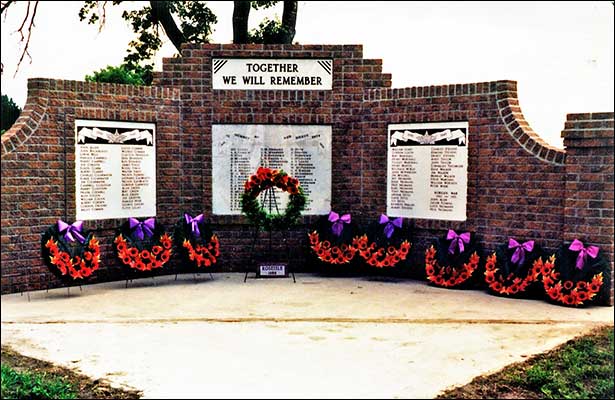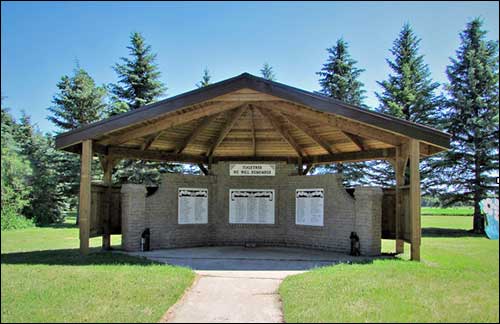The Roseisle War Memorial, from 1989, is one of the few Manitoba war memorials with architectural aspirations. Some of these monuments are, quite literally, buildings, but others, like the Roseisle memorial, have qualities of design and appearance that make them appear as building‐like forms, or at least as elements of buildings—columns, walls, or arches. The architectural elements have recently been enhanced by addition of a shelter to protect the marble name plaques.
The designers of the Roseisle War Memorial used an entirely familiar building element—a brick wall—abstracted by the use of pillars at the edges and elegantly curved transitional elements, to create a powerful and memorable object. The memorial features 62 names of local men who served in World War I, 69 from World War II and four who served in the Korean War of 1950–53. Each November 11, the community gathers here to reaffirm the epitaph: “Together We Will Remember.”
July 2014
Overcast skies and morning drizzle failed to dampen spirits or halt the WWI commemorative event July 1 in Roseisle. The community is known for its traditional Canada Day celebration—waffle breakfast, parade, tractor pull, lawn mower races, food, entertainment and spectacular fireworks. This year’s special heritage event added a new dimension to being ‘Canada Proud’.
Roseisle area sent 62 young men to war in 1914–18; eight of them did not return. Local students ages 10 to 15 each selected one of the soldiers to learn about their life and the circumstances of their death on the battlefield. On July 1, the students presented profiles of ‘their’ soldiers and placed name tags on roses they planted in a special section of the Roseisle Memorial Rose Garden.
Students at Memorial Rose Garden ceremony
Candace Bergen, MP, Blaine Petersen, MLA, and George Gray, Deputy Reeve, brought official greetings to a large audience that included relatives of the fallen soldiers.
Speaking on behalf of the Carman/Dufferin Councils and Carman/Dufferin Municipal Heritage Advisory Committee (CDMHAC), George Gray lauded the project for providing young people of the community with tools to learn about their past and help preserve and promote local heritage. CDMHAC made a financial contribution towards the monument and members of the Committee helped guide the students in their research.
George noted that “Three to four generations after the First World War, there aren’t too any of us left who personally knew veterans of WWI. For most folks, these soldiers have simply become a name and an initial on a plaque. We have to thank our students for reminding that these were real people, the sons of local families. Their loss was mourned by the entire community, many of whom feared they might be next to receive the dreaded casualty notice.”
On behalf of Carman Legion #18, local veteran Rod McPherson dedicated a monument that marks the special area of the garden. He said that “this was the most beautiful thing the community could have done” for our war dead.
See also War Memorials for more information on the monument and profiles of the soldiers.Visitors check out student displays
November 2014
More Support for Roseisle Memorial Rose Garden

Rod McPherson, on behalf of Carman Legion #18, presents a cheque to Marg Neumann, Diane & Grant Gillingham
 Carman Legion #18 presented the Roseisle Memorial Rose Garden Committee with a cheque for $500 to help fund a monument which was placed in the garden this summer in memory of local soldiers who died in WWI.
Carman Legion #18 presented the Roseisle Memorial Rose Garden Committee with a cheque for $500 to help fund a monument which was placed in the garden this summer in memory of local soldiers who died in WWI.
The CDMHAC also helped fund the monument and assisted students in researching the lives of the local soldiers who died in the conflict On November 11, the students mounted a display of their research and took part in a well-attended Remembrance Day service.
Rod McPherson, Carman Legion #18
September 2019
Roseisle War Memorial Restoration. The first phase of restoration and preservation of the Roseisle cenotaph has been completed. In this phase of the project, brickwork was repaired, lettering on the plaques enhanced and new lighting installed. The work was completed thanks to grants from Veterans Affairs Canada, the Legion poppy fund and the R.M. of Dufferin.

The question the local committee now has to address is how best to protect the masonry and lettering from further deterioration. They recognize that without additional protection, the cenotaph will remain exposed to the effects of weathering. The marble plaques that record the names of local lads who served in three major conflicts — WWI, WWII and the Korean War — are particularly susceptible to our harsh Manitoba climate. The WWI plaque is now one hundred years old. In 2018, Manitoba Heritage recognized the unique architectural features and historical significance of the cenotaph by awarding the site a Heritage Certificate.
To help preserve the memorial, the committee has launched Phase 2 of the project. This will involve building a protective shelter of pressure-treated cedar-tone wood, with open-beam construction and a roof supported by three-quarter walls. Fund-raising is now under way with expectation that the project may still be completed this year.
Meanwhile, in keeping war memorial protocol, a re-dedication service will be held Sunday, October 6, at 2:00 p.m. at the site. Legion members, Cadets, Boy Scouts and local dignitaries will take part in the ceremony. Everyone is welcome and encouraged to attend.
August 2020
War Memorial Shelter. The Roseisle War Memorial now has a canopy in place to shelter it from the elements. The structure is a heritage certificate site and one of two war memorials in Carman/Dufferin municipalities. It’s also a fine example of what a small community can do when everyone pitches in to help.
Last summer, a local committee under the leadership of Frank Peters and Cheryl Smith-Tranq obtained grants to carry out major repairs to the mortar and brickwork of the cenotaph. Lettering also was restored on three plaques that list the names of 136 local soldiers who served in WWI, WWII, and the Korean War. The central WWI plaque is over 100 years old.
The committee decided to build a shelter to protect the structure from further damage from sun, rain and snow so future generations remember the sacrifices made by these soldiers and their families and the role they played in securing our own way of life.
Last October 2020, committee members knocked on local doors, made phone calls, sent emails to the families of soldiers whose names appear on the plaques and sold progressive 50/50 tickets. Six weeks later, the estimated $12,000 cost of the project was in place. Actual construction was placed on hold until 2020 and, like most projects, has been scheduled around the reality of the pandemic.



